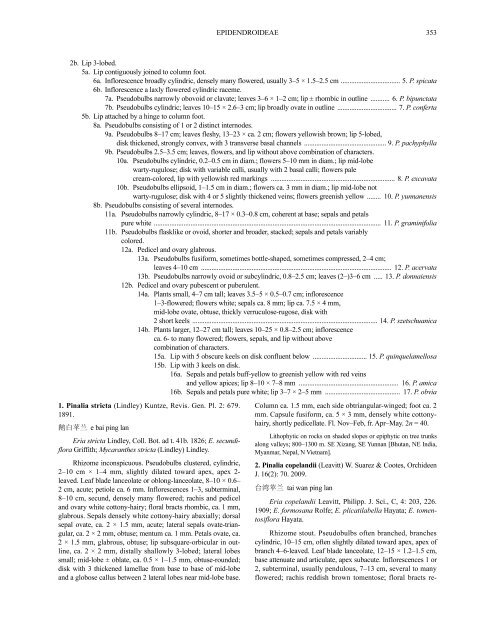Create successful ePaper yourself
Turn your PDF publications into a flip-book with our unique Google optimized e-Paper software.
EPIDENDROIDEAE<br />
2b. Lip 3-lobed.<br />
5a. Lip contiguously joined to column foot.<br />
6a. Inflorescence broadly cylindric, densely many flowered, usually 3–5 × 1.5–2.5 cm .................................. 5. P. spicata<br />
6b. Inflorescence a laxly flowered cylindric raceme.<br />
7a. Pseudobulbs narrowly obovoid or clavate; leaves 3–6 × 1–2 cm; lip ± rhombic in outline ........... 6. P. bipunctata<br />
7b. Pseudobulbs cylindric; leaves 10–15 × 2.6–3 cm; lip broadly ovate in outline .................................. 7. P. conferta<br />
5b. Lip attached by a hinge to column foot.<br />
8a. Pseudobulbs consisting of 1 or 2 distinct internodes.<br />
9a. Pseudobulbs 8–17 cm; leaves fleshy, 13–23 × ca. 2 cm; flowers yellowish brown; lip 5-lobed,<br />
disk thickened, strongly convex, with 3 transverse basal channels ............................................... 9. P. pachyphylla<br />
9b. Pseudobulbs 2.5–3.5 cm; leaves, flowers, and lip without above combination of characters.<br />
10a. Pseudobulbs cylindric, 0.2–0.5 cm in diam.; flowers 5–10 mm in diam.; lip mid-lobe<br />
warty-rugulose; disk with variable calli, usually with 2 basal calli; flowers pale<br />
cream-colored, lip with yellowish red markings ....................................................................... 8. P. excavata<br />
10b. Pseudobulbs ellipsoid, 1–1.5 cm in diam.; flowers ca. 3 mm in diam.; lip mid-lobe not<br />
warty-rugulose; disk with 4 or 5 slightly thickened veins; flowers greenish yellow ........ 10. P. yunnanensis<br />
8b. Pseudobulbs consisting of several internodes.<br />
11a. Pseudobulbs narrowly cylindric, 8–17 × 0.3–0.8 cm, coherent at base; sepals and petals<br />
pure white .................................................................................................................................. 11. P. graminifolia<br />
11b. Pseudobulbs flasklike or ovoid, shorter and broader, stacked; sepals and petals variably<br />
colored.<br />
12a. Pedicel and ovary glabrous.<br />
13a. Pseudobulbs fusiform, sometimes bottle-shaped, sometimes compressed, 2–4 cm;<br />
leaves 4–10 cm ............................................................................................................. 12. P. acervata<br />
13b. Pseudobulbs narrowly ovoid or subcylindric, 0.8–2.5 cm; leaves (2–)3–6 cm ..... 13. P. donnaiensis<br />
12b. Pedicel and ovary pubescent or puberulent.<br />
14a. Plants small, 4–7 cm tall; leaves 3.5–5 × 0.5–0.7 cm; inflorescence<br />
1–3-flowered; flowers white; sepals ca. 8 mm; lip ca. 7.5 × 4 mm,<br />
mid-lobe ovate, obtuse, thickly verruculose-rugose, disk with<br />
2 short keels .......................................................................................................... 14. P. szetschuanica<br />
14b. Plants larger, 12–27 cm tall; leaves 10–<strong>25</strong> × 0.8–2.5 cm; inflorescence<br />
ca. 6- to many flowered; flowers, sepals, and lip without above<br />
combination of characters.<br />
15a. Lip with 5 obscure keels on disk confluent below ............................... 15. P. quinquelamellosa<br />
15b. Lip with 3 keels on disk.<br />
16a. Sepals and petals buff-yellow to greenish yellow with red veins<br />
and yellow apices; lip 8–10 × 7–8 mm ......................................................... 16. P. amica<br />
16b. Sepals and petals pure white; lip 3–7 × 2–5 mm ........................................... 17. P. obvia<br />
1. Pinalia stricta (Lindley) Kuntze, Revis. Gen. Pl. 2: 679.<br />
1891.<br />
鹅白苹兰 e bai ping lan<br />
Eria stricta Lindley, Coll. Bot. ad t. 41b. 1826; E. secundiflora<br />
Griffith; Mycaranthes stricta (Lindley) Lindley.<br />
Rhizome inconspicuous. Pseudobulbs clustered, cylindric,<br />
2–10 cm × 1–4 mm, slightly dilated toward apex, apex 2leaved.<br />
Leaf blade lanceolate or oblong-lanceolate, 8–10 × 0.6–<br />
2 cm, acute; petiole ca. 6 mm. Inflorescences 1–3, subterminal,<br />
8–10 cm, secund, densely many flowered; rachis and pedicel<br />
and ovary white cottony-hairy; floral bracts rhombic, ca. 1 mm,<br />
glabrous. Sepals densely white cottony-hairy abaxially; dorsal<br />
sepal ovate, ca. 2 × 1.5 mm, acute; lateral sepals ovate-triangular,<br />
ca. 2 × 2 mm, obtuse; mentum ca. 1 mm. Petals ovate, ca.<br />
2 × 1.5 mm, glabrous, obtuse; lip subsquare-orbicular in outline,<br />
ca. 2 × 2 mm, distally shallowly 3-lobed; lateral lobes<br />
small; mid-lobe ± oblate, ca. 0.5 × 1–1.5 mm, obtuse-rounded;<br />
disk with 3 thickened lamellae from base to base of mid-lobe<br />
and a globose callus between 2 lateral lobes near mid-lobe base.<br />
353<br />
Column ca. 1.5 mm, each side obtriangular-winged; foot ca. 2<br />
mm. Capsule fusiform, ca. 5 × 3 mm, densely white cottonyhairy,<br />
shortly pedicellate. Fl. Nov–Feb, fr. Apr–May. 2n = 40.<br />
Lithophytic on rocks on shaded slopes or epiphytic on tree trunks<br />
along valleys; 800–1300 m. SE Xizang, SE Yunnan [Bhutan, NE India,<br />
Myanmar, Nepal, N Vietnam].<br />
2. Pinalia copelandii (Leavitt) W. Suarez & Cootes, Orchideen<br />
J. 16(2): 70. 2009.<br />
台湾苹兰 tai wan ping lan<br />
Eria copelandii Leavitt, Philipp. J. Sci., C, 4: 203, 226.<br />
1909; E. formosana Rolfe; E. plicatilabella Hayata; E. tomentosiflora<br />
Hayata.<br />
Rhizome stout. Pseudobulbs often branched, branches<br />
cylindric, 10–15 cm, often slightly dilated toward apex, apex of<br />
branch 4–6-leaved. Leaf blade lanceolate, 12–15 × 1.2–1.5 cm,<br />
base attenuate and articulate, apex subacute. Inflorescences 1 or<br />
2, subterminal, usually pendulous, 7–13 cm, several to many<br />
flowered; rachis reddish brown tomentose; floral bracts re-
















